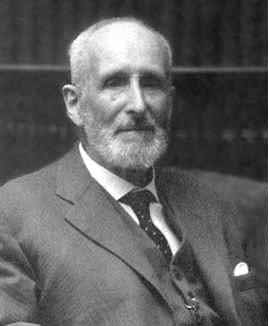


 تاريخ الرياضيات
تاريخ الرياضيات
 الرياضيات في الحضارات المختلفة
الرياضيات في الحضارات المختلفة 
 الرياضيات المتقطعة
الرياضيات المتقطعة
 الجبر
الجبر
 الهندسة
الهندسة 
 المعادلات التفاضلية و التكاملية
المعادلات التفاضلية و التكاملية 
 التحليل
التحليل
 علماء الرياضيات
علماء الرياضيات |
Read More
Date: 31-5-2017
Date: 31-5-2017
Date: 31-5-2017
|
Born: 7 May 1880 in Frankenthal, Pfalz, Germany
Died: 22 February 1975 in Munich, Germany

Oskar Perron studied classics at school and, despite his father wishing him to continue the family business, he studied mathematics in his spare time. In 1898 Perron entered the University of Munich and, in keeping with the custom of the time to spend semesters at different universities, he also studied at the universities of Berlin, Tübingen and Göttingen.
Perron was most influenced by his teachers at Munich. Pringsheim's lectures at Munich made a lasting impression on Perron and their influence extended to Perron work on continued fractions Die Lehre von den Kettenbrüchen which was published in 1913. Geometry became the topic of Perron's doctoral thesis directed by Lindemann and Perron went on to complete his habilitation at Munich and was appointed a lecturer there in 1906.
In 1910 Perron accepted the offer of a post as extraordinary professor at Tübingen and then, in 1914, he became an ordinary professor at Heidelberg. However World War I disrupted his career and, in 1915, he undertook war work which was to earn him the Iron Cross. At the end of the war he returned to Heidelberg where he taught until 1922 when he was appointed to a chair at Munich.
In [1] 218 publications by Perron are listed in a bibliography which he compiled himself. These publications cover a wide range of mathematical topics. His work in analysis is certainly remembered through the Perron integral. However he also worked on differential equations, matrices and other topics in algebra, continued fractions, geometry and number theory.
Perron published a number of important texts. In addition to the work on continued fractions mentioned above, which in fact ran to three editions the last being a two volume version in 1954/57, he published an important text on irrational numbers in 1921. This text was designed to require only school level mathematics as a prerequisite and the topic was skilfully developed in a beautiful self-contained way. Again this was a text which ran to several editions and Perron revised the text in 1960 when he was aged 80.
One of the things he is best-known for is the Perron paradox which highlights the danger of assuming that a solution to a problem exists. He introduced this as part of the discussion of Steiner's attempted proof of an isoperimetric problem. The paradox runs as follows:
Suppose the largest natural number is N. Then if N > 1 we have N2 > N contradicting the definition. Hence (!) N = 1.
A two volume work on algebra first appeared in 1927 with the third revised edition being published in 1951. Perhaps most remarkable of all was his text on non-euclidean geometry which he published at the age of 82. Frank, in [1], writes:-
This work won the approval of the entire mathematical world due to its great worth and masterful presentation. It is of interest not only to students of mathematics and physics but also especially to teachers of mathematics.
Despite the large amount of mathematics which Perron produced over a long career, he also had other interests. These are described in [1] and included:-
... his love of the mountains of his surroundings. No vacation would have been complete without the mountains. As well as higher mountains, he climbed the 2200 meter Totenkirchl in the Wilder Kaiser more than twenty times, the last time when he was 74.
Although Perron formally retired in 1951, he continued to teach certain courses at Munich until 1960. However even when he ended his teaching at the age of 80 he was still able to continue with a vigorous research program, publishing 18 papers between 1964 and 1973.
Articles:



|
|
|
|
دخلت غرفة فنسيت ماذا تريد من داخلها.. خبير يفسر الحالة
|
|
|
|
|
|
|
ثورة طبية.. ابتكار أصغر جهاز لتنظيم ضربات القلب في العالم
|
|
|
|
|
|
|
بالصور: ممثل المرجعية العليا والامين العام للعتبة الحسينية يستقبلون المهنئين القاصدين مرقد الامام الحسين (ع) في عيد الفطر المبارك
|
|
|